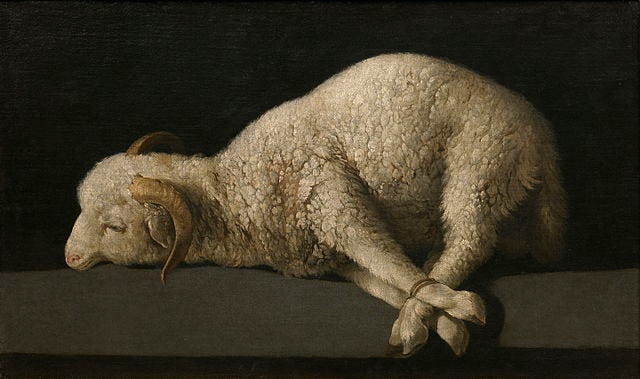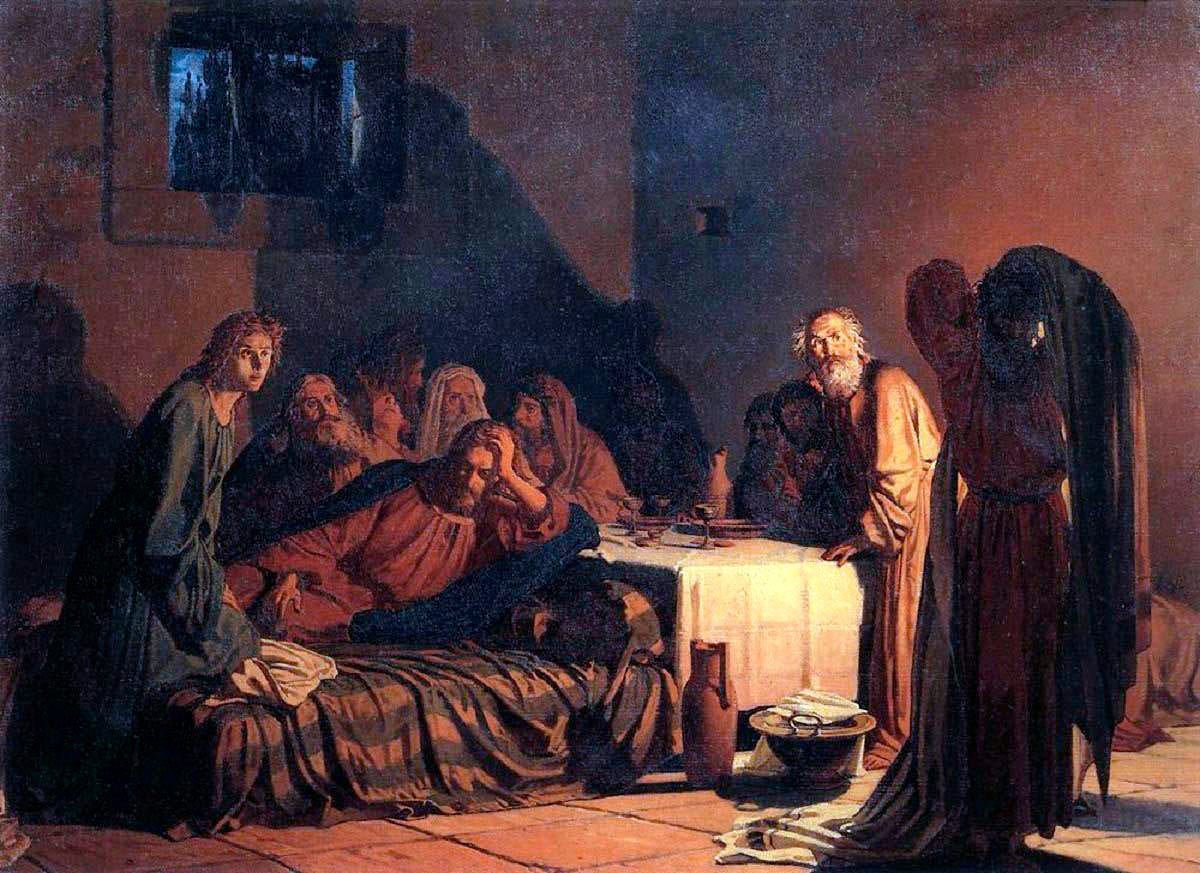Is Christ, in a Most Literal Way, the New Passover Lamb?
Understanding the Eucharist in Light of the Jewish Passover
The significance of the Eucharist and its literal meaning is not only lost among denominational translations, it’s also been lost to history in the aged disconnect from the Jewish faith. As many Christians know, Jesus and his disciples didn’t consider themselves “Christians” at the time. They were Jewish–the people of Israel. They followed God’s Law, as it was passed down to Moses through the commandments.
But as time has gone on, the Jewish heritage and foundations of Christianity have been, for the most part, disconnected. In some Christian liturgical practices today, the Old Testament Scriptures may be omitted completely, seen as irrelevant or outdated. Jesus established the New Covenant, right? Out with the Old and in with the New?
I wouldn’t be so sure. The significance of Jesus coming again as the Messiah is great, of course, but what’s often glossed over is the Eucharist itself. And when we consider the Eucharist in the eyes of the Jewish culture, our understanding is taken to a completely new level. One, that I’d argue, cannot be ignored.
Ignoring this fact would, in turn, be ignoring the words and intention of Christ Himself. As we dive into this post, we’ll begin to understand much more deeply how the Eucharist is so integrally tied to the Jewish understanding of the Messiah. One that cannot be separated from Christ’s fulfillment of the Old Covenant itself. And one way is in the Jewish Passover.
The New Passover
The Passover, to this day, is considered one of the most significant feasts in the Jewish faith. Going back to the time of the Israelites’ slavery in Egypt, to the time of Jesus, and to this very day, Jewish people celebrate this holiday every year. It commemorates the day that the Angel of Death passed over the Israelites, killing the firstborn Egyptian sons, as God’s response of Pharaoh’s hardened heart.
Through Moses, the Lord passed along instructions to the Israelites, outlining exactly what they must do in preparation of that historic night. When viewing these exact steps, it’s unmistakably and undeniably connected to the institution of the Eucharist and how it’s practiced in many Christian denominations through their liturgy today. And further, how the continued liturgical practice of the Eucharist itself is in keeping with the Lord’s command to continue this feast forever.
“This day shall be for you a memorial day, and you shall keep it as a feast to the Lord; throughout your generations shall you observe it as an ordinance for ever.” - Exodus 12:14
On the night of the Passover, the people of Israel were commanded to take a male, unblemished lamb, sacrifice it, spread its blood, eat the flesh of the lamb, and lastly, keep The Passover as a remembrance.
When selecting a lamb, it had to be perfect. As Brant Pitre writes in his book, The Jewish Roots of the Eucharist, “It had to be free of defects. The lamb could not be maimed, lame, or diseased in any way. It had to be perfect.” Analogously, Christ was later the unblemished lamb of The New Passover—innocent and free of sin. The perfect sacrificial lamb.
From there, the lamb was sacrificed, a traditionally and uniquely priestly action and was done so after the Exodus until the fall of the temple in 70 AD. The lamb’s blood was spilt, collected, and spread over the lintel of the wooden doorpost with a sprig of hyssop. Just as Christ was sacrificed on a tree (wooden cross), his blood too was shed. Not coincidentally, hyssop was also seen during Christ’s crucifixion.
That night, the flesh of the lamb was to be eaten, “roasted; with unleavened bread with bitter herbs, they shall eat it.” Exodus 12:8. Most noteably, you find that the completion of the sacrifice of the lamb was not until it was eaten. Again, Pitre writes, “For, as any ancient Jew would have known, the Passover Sacrifice was not completed by the death of the lamb, but by eating its flesh.”
“They will consume its meat that same night, eating it roasted with unleavened bread and bitter herbs. Do not eat any of it raw or even boiled in water, but roasted, with its head and shanks and inner organs. You must not keep any of it beyond the morning; whatever is left over in the morning must be burned up. This is how you are to eat it: with your loins girt, sandals on your feet and your staff in hand, you will eat it in a hurry. It is the LORD’s Passover. For on this same night I will go through Egypt, striking down every firstborn in the land, human being and beast alike, and executing judgment on all the gods of Egypt—I, the LORD!" - Exodus 12:8-12
Last, but absolutely not least, is the directive by the Lord to keep the Passover in perpetuity. He says:
14 This day will be a day of remembrance for you, which your future generations will celebrate with pilgrimage to the LORD; you will celebrate it as a statute forever.
This passage is strikingly reminiscent of Christ’s message at the Last Supper, which also not coincidentally, occurred on the night of the Passover.
“Do this in remembrance of me” He says in Luke 22:19.
Two Other Noteworthy Passages
As if the Old Testament Passover wasn’t prophetic enough, I wanted to highlight two other areas of significance.
Exodus 12:43-44 states that no one outside of those part of the covenant should partake in eating the flesh of the lamb, but that they must be circumcised first. This concept is consistent with modern Church tradition in both Orthodox and Catholic doctrine. In order to partake in the Eucharist, one must be baptized, in communion with the Christian Church, and believe what the Church believes: the “circumcision” of the New Covenant. This has roots in the Early Church.
Justin Martyr, one of the more prominent Early Church Fathers, wrote in Chapter 66 of his “First Apology,” this passage:
"And this food is called among us Εὐχαριστία [the Eucharist], of which no one is allowed to partake but the man who believes that the things which we teach are true, and who has been washed with the washing that is for the remission of sins, and unto regeneration, and who is so living as Christ has enjoined."
As a “non-traditional Catholic”—baptized Catholic as an infant and celebrated First Communion, but was Confirmed at 28—with a wife who converted from Protestant at the same time, she didn’t participate in Holy Communion until her Confirmation. She, to a degree, felt excluded from the faith for years leading up to that point, as though she wasn’t “part of the club” like everyone else, even though she also had a reverent love for Christ.
While it’s sad to see someone feeling excluded in that way, it makes sense when understanding the bigger picture of Holy Scripture that extends beyond doctrine. And we see that here in Exodus.
The other profound passage, later in Exodus 12:46 is a prophetic verse that’s echoed throughout the Old and New Testaments:
It must be eaten in one house; you may not take any of its meat outside the house.k You shall not break any of its bones.*
Not only is it first referenced in Psalm 34:20, it’s reintroduced in the Gospel of John:
“An eyewitness has testified, and his testimony is true; he knows* that he is speaking the truth, so that you also may [come to] believe.t For this happened so that the scripture passage might be fulfilled: “Not a bone of it will be broken.”u. John 19:35-36
This is significant because it underscores the Messianic connection with Jesus. Which is just another prophesy fulfilled among many, but it’s uncontrovertibly tied back to this very Passover and the Passover lamb.
Is Jesus Himself the Passover Lamb?
In light of this connection, it’s hard to read the words of Jesus at The Last Supper in a merely symbolic interpretation. The conclusion of The Passover itself was directly tied to physically eating the flesh of the lamb, not just its sacrifice. Just like how Christ was sacrificed, and the Eucharist continued afterward until this very day.
Jewish tradition holds that redemption will take place (or took place, in the past-tense Christian view) is on the Passover itself. Rabbi Joshua, son of Hananiah, was a prominent Jewish priest in the second century that served following the destruction of the second temple. He writes in his commentary on Exodus 12:42, “In that night they were redeemed, and in that night they will be redeemed,” indicating that redemption will take place during the Passover.
Yes, just like how Christ held the Last Supper, was crucified on that Passover night, and how we continue to feast on the flesh of the lamb—the Body and Blood of Christ in the Eucharist—until Christ comes again.
Some may look at this with skepticism, still compelled to believe that it was all symbolic. But I urge you to not simply take my word for it.
Do your own research to the extent that it undeniably pulls you completely in one belief or another—believing that the Eucharist is the physical Body and Blood of our Lord, instituted by Christ Himself… or not.
Given Christ’s command to “do this in remembrance of me” and His life-giving statements made in the bread of life discourse in John 6 (see my last post, “The ‘Radical’ Eucharist: Idol, Symbol, or Christ Himself?”), I’d argue that you can’t be a Christian and take a middle ground on this issue.
Post Script
Reader
shared with me the following astute observation:“One thing that stands out to me, and that’s the significance of Jesus connecting his death to Passover (the holiday celebrating freedom from Egypt) instead of Yom Kippur (the holiday bringing forgiveness of sins). Jesus’ death brings forgiveness , sure, but the connotation is that this is ultimately for humans’ liberation from death, sin, and the devil.”
He’s absolutely right in this. Not only is the significant connection of The Passover lamb present, but also between the freedom of Egypt and the way that Christ’s death freed humanity from the bounds of spiritual death.
In Yom Kippur (also known as the Day of Atonement), of which Jewish tradition claims has roots back to the Exodus itself following the worship of the golden calf around 1440 B.C., is celebrated for the repentence and forgiveness on sins. Even today.
The Passover, in comparison to Yom Kippur, is more holistically representative of Christ’s gift for us, even though Christ’s sacrifice is iconic because of the forgiveness of sin. Why? Because forgiveness is only the means, not the end, of His gift.
Be sure to check out his page for more from him and his Substack below.
Yours in Christ,
Josh






